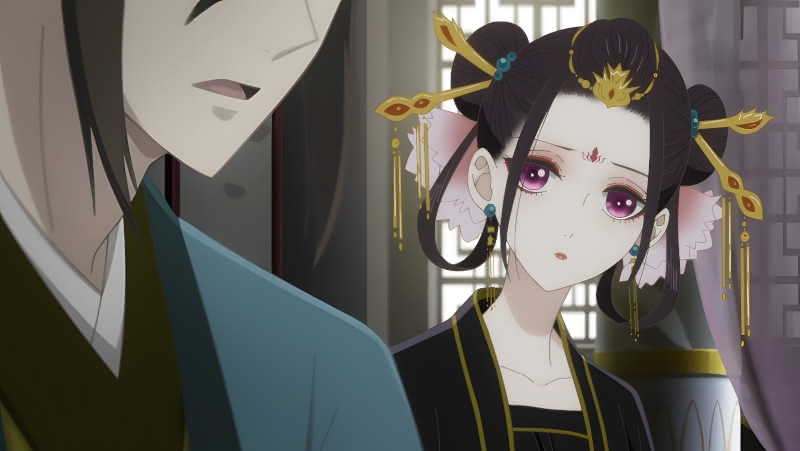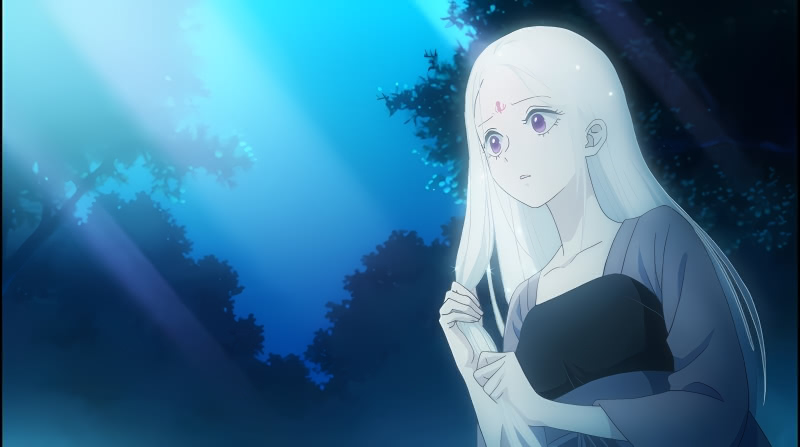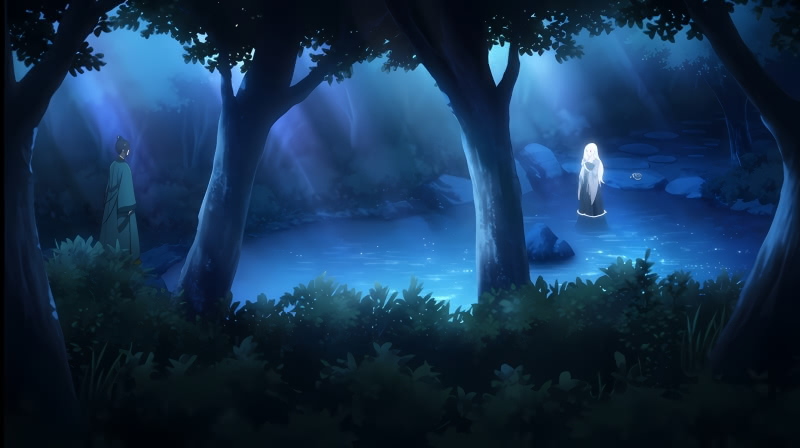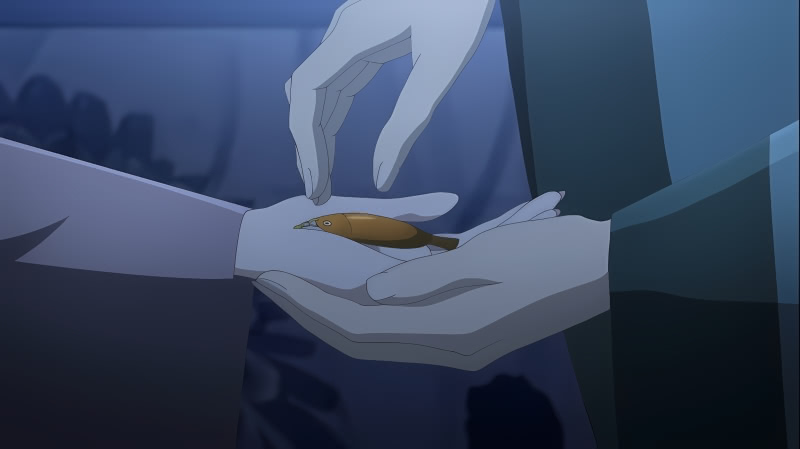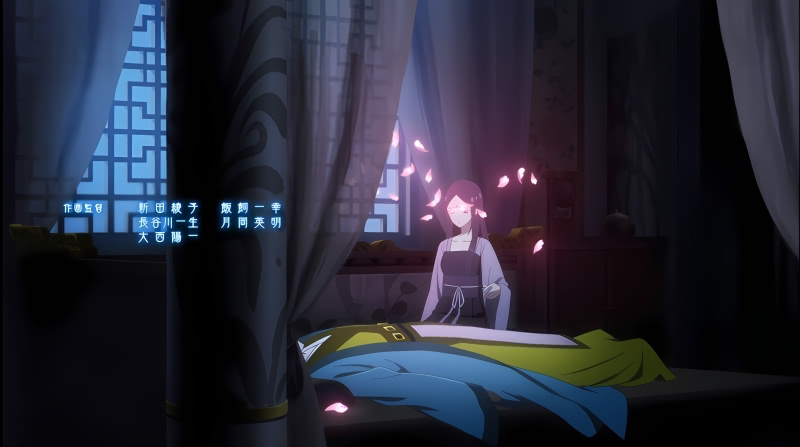Raven of the Inner Palace is an ongoing Japanese light novel series. In the fall anime season of 2022, part of the novel series was adapted into a 13-episode anime series. While the anime had some flaws in the form of strange pacing and structure and inconsistent production values, I generally liked it and included it on my list of the six best series of 2022. The series has a fantasy setting based on imperial China.
As I write this, a new and unrelated anime series that also has a fictional setting inspired by imperial China – The Apothecary Diaries – is ongoing. I was inspired to write a short article about interpreting certain unnatural hair colors in The Apothecary Diaries as part of my series on understanding unnatural hair colors in specific Japanese anime, manga, and light novel series and games. My short article on The Apothecary Diaries reminded me of an interesting use of unnatural hair color in Raven of the Inner Palace in which we are directly told how that characteristic is understood in the show’s world.
(See my full collection of posts on hair color in Japanese anime, manga, novels, and games.)
(This article spoils the end of episode 1 and much of episode 2 of Raven of the Inner Palace. It does not spoil anything beyond episode 2. In light of the fact that the series is 13 episodes, I consider the spoilers in this article to be minor. However, if you have any interest in Raven of the Inner Palace – see my short review from January 2023 – you may prefer to watch the first two episodes before continuing with this article.)
Before endeavoring to understand hair color in the specific world of an anime series, we must understand the world. As I explained in my first 2D person hair color piece, a show with a strong fantasy setting is generally going to be more likely to understand unnatural hair colors literally than a show with a real-world setting and no magic or supernatural elements. These rules are not absolute – see for example my discussion of green hair in My Senpai is Annoying – but interpreting the setting of the anime generally offers a good starting point.
As I noted at the top, Raven of the Inner Palace is set in a fictional version of ancient China. Unlike The Apothecary Diaries, however, which has a fictional setting inspired by Ming Dynasty China, Raven of the Inner Palace has supernatural elements front-and-center. The series takes place in the Emperor’s Inner Palace – which is populated by the Emperor, eunuchs, and female servants and concubines. The main protagonist is the Raven Consort, Liu Shouxue, who despite her “Consort” title, is not, in fact, a concubine and, for reasons related to the series’ mythology, was actually supposed to have no contact with the Emperor. The Raven Consort has the ability to communicate with and exorcise spirits and use what appears to be forms of magic. Thus, while the series’ setting appears to be mostly realistic, magic and supernatural elements – generally centered on the Raven Consort – do exist in the world.
The characters, all of whom are Chinese, are generally depicted with either black or brown hair. Given the fact that the series is set in ancient China and all of the characters appear to be Chinese, black would be the expected hair color. However, absent contrary evidence, using brown hair where black hair would usually be expected is not necessarily indicative of literal brown hair intent (see cases where there is contrary evidence in my discussions of Ippon! Again and The Girl I Like Forgot Her Glasses). In this case, I have no reason to believe that the fact many characters were depicted with brown hair instead of black hair had any significance beyond aesthetics.
Liu Shouxe, the Raven Consort, appears to have the expected black hair.
Or does she? At the end of the first episode, we, and by extension the Emperor, Xia Gaojun, and his most-trusted guard, happen upon the Raven Consort washing her hair in a pond. Her natural hair color turns out to be a surprise:
Shouxe’s hair is actually silver!
Shouxe is only 16 years old, so her hair color is unlikely the product of age. Moreover, her reaction when the Emperor happens upon her suggests that she had reason to hide her silver hair:
The truth, as it turns out, is that the Raven Consort, unbeknownst to everyone, was a surviving member of the previous imperial dynasty. The prior imperial family had silver hair. When the current Emperor’s grandfather seized power, he ordered the execution of all members of the removed imperial family. Silver hair marked them for death.
Shouxe’s mother escaped the initial purge with her Shouxe in part by dying both of their hair black. However, Shouxe’s mother was caught and murdered in front of Shouxe, who escaped capture. After Shouxe was initially sold into slavery, fate selected her as next in line to be Raven Consort, and the prior Raven Consort took her under her wing (pun intended). Shouxe became Raven Consort after the death of her predecessor.
Although Shouxe now had an important albeit ill-defined position in the imperial palace, she continued dying her hair black in order to conceal that she was a member of the previous dynasty. She did this because the execution order for all members of the previous dynasty remained in effect and her natural silver hair established that she fell within the ambit of the execution order. It was for that reason that she ran when the Emperor saw her silver hair.
Fortunately, luck was on Shouxe’s side.
Earlier in the first episode, the still-new Emperor insisted on meeting Shouxe in disregard of the fact that he was not supposed to have contact with the Raven Consort. He went to Shouxe with a request. While she immediately found him to be annoying, she took the request. The Emperor took an immediate liking to Shouxe despite her standoffish attitude.
After happening upon Shouxe washing her hair, he followed her to her palace to return her wash basin. The Emperor assured her that he had not seen anything and left her.
At the end of the second episode, the Emperor visited Shouxe with sweets as a reward for her completing the request he had brought to her in the first episode. He also brought up her hair color and the fact that she was a member of the previous dynasty. The Emperor pledged to Shouxe that he would not kill her, notwithstanding the still effective order entered by his late grandfather, who had founded the dynasty not long prior. When Shouxe told the Emperor that she hated herself because she had done nothing as her mother was murdered, the Emperor explained that he could relate because his own mother was made to suffer before being murdered by the Empress Dowager (whom the current Emperor deposed to take the throne). The Emperor then gave Shouxe a fish that he carved to symbolize his pledge to her to ensure her safety.
Following this pledge, the Emperor unexpectedly asks Shouxe to become his own consort – despite that request being against the rules. After Shouxe responds negatively, and the Emperor hand-waves his request as a fatigue-driven indiscretion. However, he then states to Shouxe’s embarrassment that he had never seen anything as beautiful as her with her silver hair before he passes out in her chamber. Shouxe, who is annoyed about the Emperor falling asleep on her bed, nevertheless casts a spell to give him good dreams.
(For whatever it is worth, the end scene of the first episode where Emperor Gaojun stumbles upon Shouxe washing her hair is the prettiest scene of the series and despite the series’ inconsistent production values, the team clearly put thought into depicting Shouxe with her natural silver hair in the small number of scenes wherein it appears.)
Unnatural hair colors in The Apothecary Diaries appear to be entirely aesthetic and lacking in significance to the story. Conversely, Shouxe’s silver hair in Raven of the Inner Palace is understood literally in the show’s world and relates to an important part of her past before becoming Raven Consort. In the context of the first two episodes, the Emperor’s learning the truth of her origin and responding in the manner he did play a role in establishing a baseline level of trust between the two characters who were never supposed to meet.
It occurred to me while putting this article together that the creator was likely inspired by albinism in choosing to give Shouxe and her now-deceased family silver-white hair. See, for example, my discussion of albinism in a visual novel called Red Shift. However, I do not think that Raven in the Inner Palace presents a case of literal albinism. Specifically, there is no indication that Shouxe has any characteristics commonly associated with albinism other than her hair. I submit as evidence that Shouxe’s appearance is not a subject of great interest when she dyes her hair black. However, if anyone who is familiar with the source material has a different understanding, do send an email summarizing the evidence.
